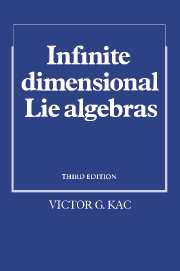Book contents
- Frontmatter
- Contents
- Introduction
- Notational Conventions
- Chapter 1 Basic Definitions
- Chapter 2 The Invariant Bilinear Form and the Generalized Casimir Operator
- Chapter 3 Integrable Representations of Kac–Moody Algebras and the Weyl Group
- Chapter 4 A Classification of Generalized Cartan Matrices
- Chapter 5 Real and Imaginary Roots
- Chapter 6 Affine Algebras: the Normalized Invariant Form, the Root System, and the Weyl Group
- Chapter 7 Affine Algebras as Central Extensions of Loop Algebras
- Chapter 8 Twisted Affine Algebras and Finite Order Automorphisms
- Chapter 9 Highest-Weight Modules over Kac–Moody Algebras
- Chapter 10 Integrable Highest-Weight Modules: the Character Formula
- Chapter 11 Integrable Highest-Weight Modules: the Weight System and the Unitarizability
- Chapter 12 Integrable Highest-Weight Modules over Affine Algebras. Application to η-Function Identities. Sugawara Operators and Branching Functions
- Chapter 13 Affine Algebras, Theta Functions, and Modular Forms
- Chapter 14 The Principal and Homogeneous Vertex Operator Constructions of the Basic Representation. Boson–Fermion Correspondence. Application to Soliton Equations
- Index of Notations and Definitions
- References
- Conference Proceedings and Collections of Papers
Introduction
Published online by Cambridge University Press: 04 August 2010
- Frontmatter
- Contents
- Introduction
- Notational Conventions
- Chapter 1 Basic Definitions
- Chapter 2 The Invariant Bilinear Form and the Generalized Casimir Operator
- Chapter 3 Integrable Representations of Kac–Moody Algebras and the Weyl Group
- Chapter 4 A Classification of Generalized Cartan Matrices
- Chapter 5 Real and Imaginary Roots
- Chapter 6 Affine Algebras: the Normalized Invariant Form, the Root System, and the Weyl Group
- Chapter 7 Affine Algebras as Central Extensions of Loop Algebras
- Chapter 8 Twisted Affine Algebras and Finite Order Automorphisms
- Chapter 9 Highest-Weight Modules over Kac–Moody Algebras
- Chapter 10 Integrable Highest-Weight Modules: the Character Formula
- Chapter 11 Integrable Highest-Weight Modules: the Weight System and the Unitarizability
- Chapter 12 Integrable Highest-Weight Modules over Affine Algebras. Application to η-Function Identities. Sugawara Operators and Branching Functions
- Chapter 13 Affine Algebras, Theta Functions, and Modular Forms
- Chapter 14 The Principal and Homogeneous Vertex Operator Constructions of the Basic Representation. Boson–Fermion Correspondence. Application to Soliton Equations
- Index of Notations and Definitions
- References
- Conference Proceedings and Collections of Papers
Summary
La Nature est un temple où de vivants piliers
Laissent parfois sortir de confuses paroles;
L'homme y passe à travers des forêts de symboles
Qui l'observent avec des regards familiers.
Charles Baudelaire, Les Fleurs du MalИ я выхожу из пространства
В запущеннь сад величин
Osip MandelstamIntroduction
§0.1. The creators of the Lie theory viewed a Lie group as a group of symmetries of an algebraic or a geometric object; the corresponding Lie algebra, from their point of view, was the set of infinitesimal transformations. Since the group of symmetries of the object is not necessarily finite-dimensional, S. Lie considered not only the problem of classification of subgroups of GLn, but also the problem of classification of infinite-dimensional groups of transformations.
The problem of classification of simple finite-dimensional Lie algebras over the field of complex numbers was solved by the end of the 19th century by W. Killing and E. Cartan. (A vivid description of the history of this discovery, one of the most remarkable in all of mathematics, can be found in Hawkins [1982].) And just over a decade later, Cartan classified simple infinite-dimensional Lie algebras of vector fields on a finite-dimensional space.
Starting with the works of Lie, Killing, and Cartan, the theory of finite-dimensional Lie groups and Lie algebras has developed systematically in depth and scope. On the other hand, Cartan's works on simple infinite-dimensional Lie algebras had been virtually forgotten until the mid-sixties. A resurgence of interest in this area began with the work of Guillemin–Stemberg [1964] and Singer–Sternberg [1965], which developed an adequate algebraic language and the machinery of filtered and graded Lie algebras.
Information
- Type
- Chapter
- Information
- Infinite-Dimensional Lie Algebras , pp. ix - xixPublisher: Cambridge University PressPrint publication year: 1990
